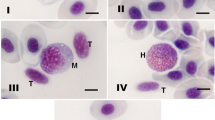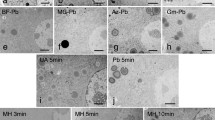Abstract
Taenia saginata, like many other cestodes1, is known to contain numerous calcareous corpuscles or calcium balls distributed throughout the parenchyma. These corpuscles, in addition to their calcium content, consist of an organic base, containing2 deoxyribo- and ribo-nucleic acids, simple proteins, glycogen and a hyaluronic acid - type of polysaccharide. With Gomori's modified technique these corpuscles also gave a positive reaction for alkaline phosphatase. The presence of calcium in these balls was indicated by von Kossa's silver test for calcium3.
This is a preview of subscription content, access via your institution
Access options
Subscribe to this journal
Receive 51 print issues and online access
$199.00 per year
only $3.90 per issue
Buy this article
- Purchase on Springer Link
- Instant access to full article PDF
Prices may be subject to local taxes which are calculated during checkout
Similar content being viewed by others
References
von Brand, T., “Chemical Physiology of Endoparasitic Animals” (Acad. Press, Inc., New York, 1952).
Chowdhury, A. B., Dasgupta, B., Ray, H. N., and Bhaduri, N. V., Bull. Calcutta School Trop. Med., 3, 52 (1955).
Glick, D., “Techniques of Histo- and Cytochemistry” (Interscience Pub., New York and London).
McGee-Russell, S. M., Nature, 175, 301 (1955).
Author information
Authors and Affiliations
Rights and permissions
About this article
Cite this article
CHOWDHURY, A., DASGUPTA, B. & RAY, H. ‘Kernechtrot’ or Nuclear Fast Red in the Histochemical Detection of Calcareous Corpuscles in Taenia saginata . Nature 176, 701–702 (1955). https://doi.org/10.1038/176701b0
Issue Date:
DOI: https://doi.org/10.1038/176701b0
This article is cited by
-
The structure, composition, formation and possible functions of calcareous corpuscles in Trilocularia acanthiaevulgaris Olsson 1867 (Cestoda, Tetraphyllidea)
Parasitology Research (1987)
-
A comparative study ofTrilocularia acanthiaevulgaris Olsson 1867 (Cestoda, Tetraphyllidea) from the stomach and spiral valve of the spiny dogfish
Zeitschrift f�r Parasitenkunde Parasitology Research (1984)
-
Observations on calcareous corpuscles using a scanning electron microscope
Experientia (1981)
-
A new approach for studies on calcareous corpuscles in Hymenolepis microstoma
Zeitschrift f�r Parasitenkunde (1974)
Comments
By submitting a comment you agree to abide by our Terms and Community Guidelines. If you find something abusive or that does not comply with our terms or guidelines please flag it as inappropriate.



